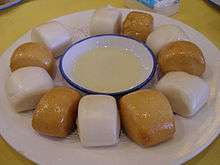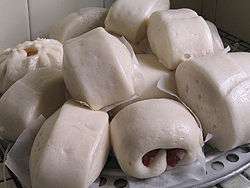Mantou
|
Classic white mantou | |
| Alternative names | Chinese steamed bun, Chinese steamed bread |
|---|---|
| Type | Bread, dim sum |
| Place of origin | China |
| Main ingredients | Wheat flour, water, leavening agents |
|
| |
| Mantou | |||||||||||||||||||
| Simplified Chinese | 馒头 | ||||||||||||||||||
|---|---|---|---|---|---|---|---|---|---|---|---|---|---|---|---|---|---|---|---|
| Traditional Chinese | 饅頭 | ||||||||||||||||||
| |||||||||||||||||||
| Alternative Chinese name | |||||||||||||||||||
| Simplified Chinese | 面头 | ||||||||||||||||||
| Traditional Chinese | 麵頭 | ||||||||||||||||||
| |||||||||||||||||||
Mantou (Chinese: ![]() 馒头), often referred to as Chinese steamed bun/bread, is a type of cloud-like steamed bread or bun popular in Northern China.[1] The name mantou is said to have originated from a tale about Zhuge Liang.[1]
馒头), often referred to as Chinese steamed bun/bread, is a type of cloud-like steamed bread or bun popular in Northern China.[1] The name mantou is said to have originated from a tale about Zhuge Liang.[1]
Description
Mantou are typically eaten as a staple food in northern parts of China where wheat, rather than rice, is grown. They are made with milled wheat flour, water and leavening agents. In size and texture, they range from 4 centimetres (1.6 in), soft and fluffy in the most elegant restaurants, to over 15 centimetres (5.9 in), firm and dense for the working man's lunch. As white flour, being more heavily processed, was once more expensive, white mantou were something of a luxury in pre-industrial China.
Traditionally, mantou, bing, and wheat noodles were the staple carbohydrates of the northern Chinese diet, analogous to rice, which forms the mainstay of the southern Chinese diet. They are also known in the south, but are often served as street food or a restaurant dish, rather than as a staple or home cooking. Restaurant mantou are often smaller and more delicate and can be further manipulated, for example, by deep frying and dipping in sweetened condensed milk.
They are often sold pre-cooked in the frozen section of Asian supermarkets, ready for preparation by steaming or heating in the microwave oven.
A similar food, but with a savory or sweet filling inside, is baozi.[2] Mantou is the older word, and in some regions (such as the Jiangnan region of China, and Korea) mantou (or the equivalent local reading of the word) can be used to indicate both the filled and unfilled buns, while in Japan the equivalent local reading of the word refers only to filled buns.
Etymology and history

The Mongols are thought to have taken the filled (baozi) style of mantou to many countries of Central and East Asia about the beginning of the Yuan Dynasty in the 13th century. The name mantou is cognate to manty and mantı; these are filled dumplings in Turkish,[3] Persian,[4] Uzbek,[5] and Pakistani ("mantu")[6] cuisines.
Some allege that this type of dish was very popular in the Han dynasty (202 BCE–220 CE), under the name bing (饼; 餅; bǐng). During the Western Jin dynasty (265–316 CE), Shu Xi (束皙) wrote about steamed cakes (蒸饼; 蒸餅; zhēngbǐng) in his "Ode to boiled cakes" (汤饼赋; 湯餅賦; tāngbǐngfù), written around 300 CE. He first called them mantou (曼头; 曼頭; màntóu). In this book, it was advised to eat this in a banquet during the approach of spring.[7]
Folklore
A popular Chinese legend relates that the name mantou actually originated from the homophonous word mántóu, which literally means "barbarian's head".
The legend was set in the Three Kingdoms period (220–280 CE) when Zhuge Liang, the Chancellor of the state of Shu Han, led the Shu army on a campaign against Nanman forces in the southern lands of Shu, which correspond to roughly present-day Yunnan, China, and northern Myanmar.
After subduing the Nanman king Meng Huo, Zhuge Liang led the army back to Shu, but met a swift-flowing river which defied all attempts to cross it. A barbarian lord informed him that in olden days, the barbarians would sacrifice 49 men and throw their heads into the river to appease the river deity and allow them to cross. As Zhuge Liang did not want to cause any more of his men to lose their lives, he ordered his men to slaughter the livestock the army brought along, and fill their meat into buns shaped roughly like human heads (round with a flat base). The buns were then thrown into the river. After a successful crossing, he named the bun "barbarian's head" (mántóu, 蠻頭, which evolved into the modern 饅頭).[8] Another version of the story relates back to Zhuge Liang's southern campaign when he instructed that his soldiers who had fallen sick from diarrhoea and other illnesses in the swampy region be fed with steamed buns with meat or sweet fillings.[9]
Variations in meaning outside northern China
Prior to the Song dynasty (960–1279), the word mantou meant both filled and unfilled buns. The term baozi arose in the Song dynasty to indicate filled buns only. As a result, mantou gradually came to indicate only unfilled buns in Mandarin and other varieties of Chinese.
In many areas, however, mantou still retains its meaning of filled buns. In the Jiangnan region where Wu Chinese is spoken, it usually means both filled and unfilled buns. In Shanxi, where Jin Chinese is spoken, unfilled buns are often called momo (饃饃), which is simply the character for "steamed bun". The name momo spread to Tibet and Nepal and usually now refers to filled buns or dumplings.[10]
The name mantou is cognate to manty and mantı; these are filled dumplings in Turkish,[11] Persian,[12] Uzbek,[13] and Pakistani ("mantu")[14] cuisines. In Japan, manjū (饅頭) usually indicates filled buns, which traditionally contain bean paste or minced meat-vegetable mixture (nikuman 肉まん "meat manjū").[15] Filled mantou are called siyopaw in Philippine,[16] from the Spanish siópao, ultimately derived from Chinese shāobāo (燒包). In Thailand, they called filled mantou as "salapao".[17] In Korea, mandu (饅頭)[18] can refer to both baozi or jiaozi (餃子). In Mongolian cuisine, manty or mantu are steamed dumplings[19] and a steamed variation is said to have led to the Korean mandu.[20] In Singapore, the dish chilli crab is commonly served with a fried version of mantou.[21][22][23]
See also
| Wikimedia Commons has media related to Mantou. |
References
- 1 2 Graves, Helen (2 October 2013). "Chinese food and drink: Pork belly mantou – recipe". TheGuardian.com. Guardian News & Media LLC. Retrieved 28 January 2015.
- ↑ Hsiung, Deh-Ta (2002). The Chinese Kitchen: A Book of Essential Ingredients with Over 200 Easy and Authentic Recipes. New York, New York: MacMillan. p. 33. ISBN 9780312288945.
- ↑ Malouf, Greg and Lucy (2008). Turquoise: A Chef's Travels in Turkey. San Francisco: Chronicle Books. p. 244. ISBN 9780811866033.
- ↑ Civitello, Linda (2007). Cuisine and Culture: A History of Food and People. John Wiley & Sons. p. 89. ISBN 9780471741725.
- ↑ Rishi, Inderjeet (2012). Super Snacks: 100 Favorite Snacks from Five Continents. Trafford Publishing. p. 173. ISBN 9781466963559.
- ↑ Brown, Lindsay; Clammer, Paul; Cocks, Rodney (2008). Pakistan and the Karakoram Highway. Lonely Planet. p. 198. ISBN 9781741045420.
- ↑
三春之初,阴阳交际,寒气既消,《北堂书钞》卷一百四十四「消」作「除」。〉温不至热。; 三春之初,陰陽交際,寒氣既消,〈《北堂書鈔》卷一百四十四「消」作「除」。〉溫不至熱。
- ↑ Bates, Roy (2008). 29 Chinese Mysteries. Lulu.com. pp. 103–104. ISBN 9780557006199.
- ↑ Lee, Keekok (2008). Warp and Weft, Chinese Language and Culture. Strategic Book Publishing. p. 86. ISBN 9781606932476.
- ↑ Gordon, Stewart (2009). When Asia Was the World: Traveling Merchants, Scholars, Warriors, and Monks Who Created the "Riches of the "East" (Reprint ed.). Da Capo Press. p. 13. ISBN 978-0306817397.
- ↑ Malouf, Greg and Lucy (2008). Turquoise: A Chef's Travels in Turkey. San Francisco: Chronicle Books. p. 244. ISBN 9780811866033.
- ↑ Civitello, Linda (2007). Cuisine and Culture: A History of Food and People. John Wiley & Sons. p. 89. ISBN 9780471741725.
- ↑ Rishi, Inderjeet (2012). Super Snacks: 100 Favorite Snacks from Five Continents. Trafford Publishing. p. 173. ISBN 9781466963559.
- ↑ Brown, Lindsay; Clammer, Paul; Cocks, Rodney (2008). Pakistan and the Karakoram Highway. Lonely Planet. p. 198. ISBN 9781741045420.
- ↑ The East, Volumes 30-31. Tokyo: East Publications. 1994. p. 9.
- ↑ Eggs, Malcolm; Emina, Seb (2013). The Breakfast Bible. Bloomsbury Publishing. ISBN 9781408839904.
- ↑ Sukphisit, Suthon (1997). The vanishing face of Thailand: folk arts and folk culture. Post Books. p. 155. ISBN 9789742020279.
- ↑ Wong, Lee Anne (2014). Dumplings All Day Wong: A Cookbook of Asian Delights From a Top Chef. New York, New York: Macmillan. p. 51. ISBN 9781624140594.
- ↑ Bloom, Greg; Clammer, Paul; Kohn, Michael (2010). Central Asia. Lonely Planet. p. 86. ISBN 9781741791488.
- ↑ Pettid, Michael J. (2008). Korean Cuisine: An Illustrated History. Reaktion Books. p. 98. ISBN 9781861893482.
- ↑ Tan, Jeanette (28 October 2014). "Chilli crab, mantou wow MasterChef Australia's George Calombaris in Singapore". Yahoo Asia Pacific Pte. Ltd. Yahoo Entertainment, Singapore. Retrieved 28 January 2015.
- ↑ Ting, Deanna (12 December 2012). "5 Can't-Miss Singapore Dining Experiences". Successful Meetings. Northstar Travel Media LLC. Retrieved 28 January 2015.
- ↑ Sietsema, Robert (7 August 2012). "Chili Crab Dip With Mantou From Masak, Dish #71". Village Voice. Retrieved 28 January 2015.
